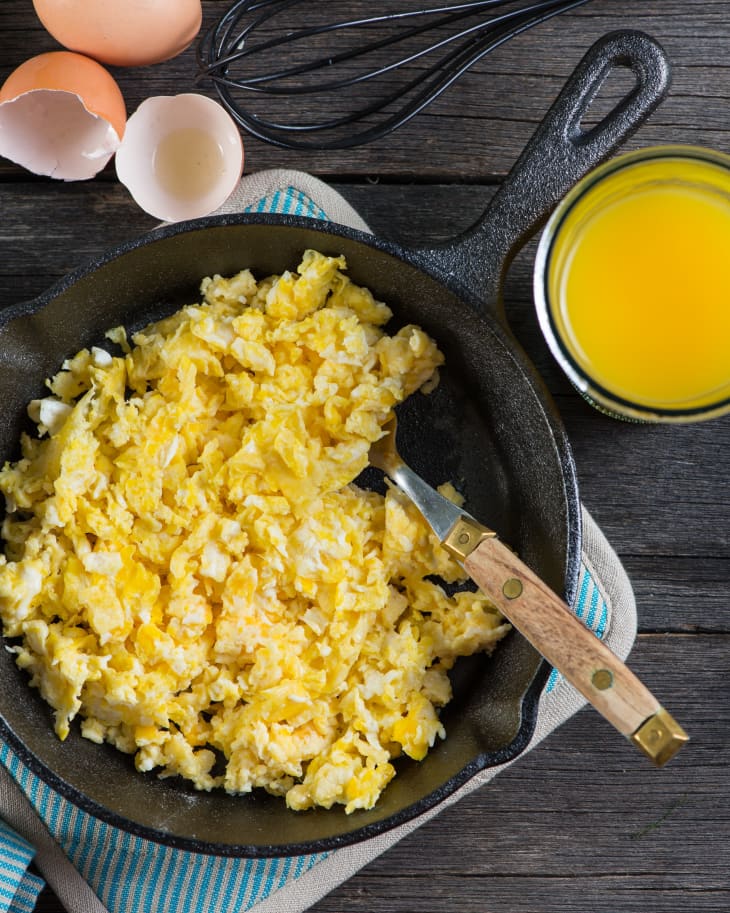10 Food Writers & Chefs Share Their Secrets for Making the Best Scrambled Eggs
Scrambled is my favorite way to eat eggs, but it hasn’t always been that way. Growing up, I associated scrambled eggs with the rubbery, tasteless stuff that was served at bad lunchroom cafeterias. In fact, it wasn’t until the end of college that I discovered a recipe that made the creamiest, most luxurious scrambled eggs of my life. I was a convert.
The very best scrambled eggs are all about personal preference, but there are small, smart things you can try that will make a big difference. Let these 10 food writers, chefs, and TV personalities show you their tips for better scrambled eggs.
It would be easy to say that adding a whole bunch of vegetables and cheese makes your scrambled eggs taste better, but that’s not the purpose of this post. I was looking for ideas that highlight the process of cooking just plain, classic, essential scrambled eggs, and small tweaks that make eggs richer or creamier.
There are generally two camps of scrambled eggs. As Slate smartly put it in their article about scrambled egg techniques – there’s the European-style scrambled egg, which is more like a savory custard (low and slow), and then there is the American-style scrambled egg recipe, which produces a more omelette-like scramble (higher heat, beating the eggs before they hit the pan).
I’m on team low-and-slow, and The Kitchn’s wonderful recipe roughly follows this technique. This post will also look more closely at how to create creamy eggs – but again, this is all about preference.
10 Food Writers & Chefs Share Their Secret for the Best Scrambled Eggs
1. Use organic free-range chicken eggs.
Across the board the biggest thing chefs and food writers alike talked about when making perfect scrambled eggs was using good eggs.
Read more: Perfect Scrambled Eggs by Marla Meridith
2. Use a saucepan, not a frying pan.
Ruth Reichl said you should use a saucepan for making scrambled eggs instead of a frying pan. The heavy-bottomed saucepan has even heat and allows for constant stirring if you want creamy eggs.
Read the tip: Ruth Reichl’s Better Scrambled Eggs at From Block to Kitchen
3. Consider the yolk-to-white ratio.
Nathan Myhrvold of Modernist Cuisine has said in a couple interviews that the key to the best scrambled eggs is to get rid of an egg white. So if you’re making a three-egg scrambled egg, you’d have three yolks and two whites. This makes for better flavor, texture, and color. (And richer eggs, obviously.)
Read the tip: Perfect Scrambled Eggs at Tasting Table
4. The temperature of your pan is important.
The temperature of your pan, both before the eggs are added and while the eggs are cooking, is important. This is the most controversial technique in making scrambled eggs, and is also based on personal preference.
The general consensus on making creamy scrambled eggs is that you want the pan to be basically cold before the eggs go in the pan. From there, medium-low heat is the way to go. Play around with this until you find what you like.
Read the tip: Slow Scrambled Eggs at I Am a Food Blog
5. Move your pan on and off the heat.
Gordon Ramsay’s video tutorial for how to make scrambled eggs has almost 11 million views on YouTube. In fact, this was the technique I first tried that made me fall in love with scrambled eggs. The thing that makes his technique stand apart, for me, is the on-and-off-the-heat method. The stove is on medium-low the whole time, but you move the saucepan on and off the heat so the eggs remain creamy.
See the method: Gordon Ramsay’s Scrambled Eggs at YouTube
6. Keep stirring, but not so much that the eggs get foamy.
Jean-Georges is known for this ridiculously delicious dish where he spoons super creamy scrambled eggs into an egg shell and tops it with whipped cream and caviar. His interesting tip for making scrambled eggs? You want to whisk constantly, but not so hard that you make egg foam.
Read the tip: How to Make Fluffy-Soft Scrambled Eggs like Jean-Georges Vongerichten atBon Appétit
7. Try adding cornstarch to your raw eggs.
Making creamy scrambled eggs takes some time. So what do you do if you’re impatient? Lady and Pups says you should add a mixture of milk and cornstarch to your raw eggs before cooking. Apparently with this trick you can make the best scrambled eggs in just 15 seconds.
Read the tip: Magic 15-Second Creamy Scrambled Eggs at Lady and Pups
8. Add crème fraîche or goat cheese to your eggs at the very end.
Instead of adding milk or cream to your eggs at the beginning or end of scrambling, try adding a dollop of goat cheese or crème fraîche. It make a tangy, creamier scrambled egg. Personally, if I don’t have one of these on hand, I’ll add Greek yogurt.
Read the tip: Goat Cheese Scrambled Eggs with Pesto Veggies t Pinch of Yum
9. Take your pan off the heat before you think you need to.
The big tip I came away with from reading Jamie Oliver’s recipe for scrambled eggs was that you want to take your eggs off the heat before you think they’re done. They will continue to cook until you eat them.
Read the tip: Scrambled Eggs at Jamie Oliver
10. Use a warm plate to serve your eggs.
Warning: This is the most Alton Brown tip for making perfect scrambled eggs. You want to make sure the plate you’re serving the finished scrambled eggs on is warm – otherwise the eggs you worked so hard to make will get cold quickly.
Read the tip: Alton Brown’s Perfect Scrambled Eggs at The Food Network
